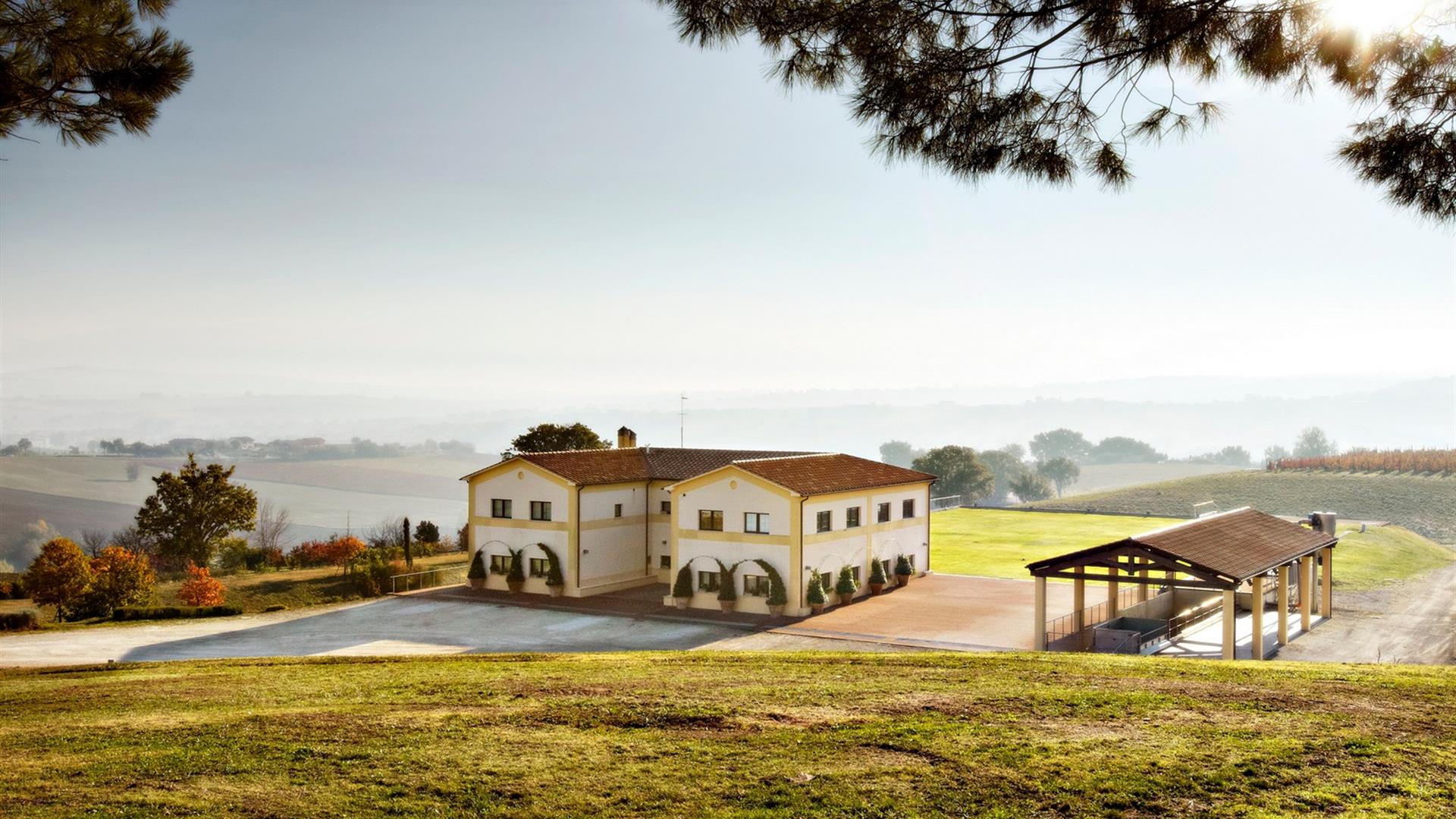Guide to the most famous Italian sweet wines, between Tuscany and Umbria
-
December 16, 2021min
Navigate to
- What distinguishes a sweet wine?
- Sweet wines between Tuscany and Umbria
- Vinsanto
- The religious tradition at the origin of the name
- Fattoria del Cerro Vinsanto
- Moscadello DOC Montalcino
- History and curiosity
- Moscadello di Montalcino DOC late harvest
- Montefalco Sagrantino passito DOCG
- Tasting Sagrantino passito in Còlpetrone estate
They are the symbol of conviviality, undisputed protagonists at the end of the meal, a noble pairring to the festive table: we are talking about sweet wines. Traditionally defined as sweet wines, thanks to the marked notes of sweetness they express great character even in new combinations and are able to enhance the aromas and flavors of aperitifs and main courses.
The winemaking tradition of central Italy offers a range of passito wines appreciated all over the world, we discover them in this mini guide to the most famous sweet wines of Tuscany and Umbria.
What distinguishes a sweet wine?
In order for a wine to be defined as sweet, it must contain a quantity of sugar higher than 45 grams per liter, a characteristic that meets most of the pairings with the traditional courses that conclude the lunch.
This type of wine is also called “passito”, it is not by chance that it is obtained from the vinification of dried grapes: once the harvest is completed, the bunches destined for this particular process find their place on racks that are placed in a warm place, in dry environments characterized by a good aeration.
At this stage the berries undergo natural dehydration, a crucial process which determines the sugar content of the final product. Once the drying phase, which can last several months, is completed, the grapes are pressed, followed by fermentation and aging in wood.
The vinification of the passito is a real ritual, the beating heart of a tradition that passes from the vineyard to the cellar and reveals itself on the table to translate the production history of the territory into flavor and mark moments in company.
We just have to discover the most famous Tuscan and Umbrian passito wines and the places to taste or buy them.
Sweet wines between Tuscany and Umbria
Vinsanto
It is one of the passito wines that speaks of Tuscany in the world. Protagonist of what has always been considered the perfect pairing of wine and dessert, it was born in the heart of the province of Siena, in the Chianti area: we are talking about Vinsanto.
It is among the most famous Italian sweet wines and is made from a sugar must with a high alcohol content obtained from the drying of Trebbiano Toscano and Malvasia Bianca grapes.
It stands out for its unmistakable fruity aroma and for its dense and sweet flavor with persistent freshness.
The religious tradition at the origin of the name
The origins of the name of this very special wine take us back several centuries and, although they are associated with a rather varied anecdote, they all converge on a religious matrix.
Among the various traditions that have come down to us, for example, there is one that dates Vinsanto back to the early Christian era, when this denomination referred to the wine used for the celebration of the Eucharistic rite. This hypothesis has come down to us intact and does not differ much from the one that places at the origin of the term “Vinsanto” the concomitance between the production phases of wine and the main feasts of the Christian liturgical calendar.
Fattoria del Cerro Vinsanto
Tasting this sweet wine means treating yourself to a full immersion in the flavors and atmospheres of the province of Siena: the best way to do this is to plan a stop at Fattoria del Cerro, in Acquaviva di Montepulciano, and booking a visit to the cellar with tasting.
Passito lovers will let themselves be conquered by the Vinsanto di Montepulciano DOC produced on the estate: this wine, awarded with the 90 points of the Wine Critic for the 2016 vintage, is recognizable on the nose for the notes of apricot, peach, fig and dried herbs and for its sweet flavor that is best expressed not only in classic pairings, as with traditional “Tuscan cantucci, but also in unusual pairings with aged goat cheeses, blue
Moscadello DOC Montalcino
Although the suggestive medieval village of Montalcino has always been synonymous with Brunello, there is an ancient and equally fine wine that has given prestige to this area: Moscadello DOC.
It is made from white Moscato grapes which, precisely in Montalcino, find the perfect combination of climatic conditions and growing soil: dry heat and good ventilation, in fact, are ideal for late harvest grapes.
Late harvest Moscadello reveals unmistakable characteristics such as a sweet and harmonious taste and intense hints of dried fruit and honey that conquer the nose.
It is the ideal choice when serving very aged cheeses, foie gras dishes or traditional Tuscan liver crostini.
History and curiosity
Present in the history of the territory of Montalcino since the seventeenth century, Moscadello boasts several famous mentions: the writer Pietro Aretino, the doctor and poet Francesco Redi and Ugo Foscolo praised its sweetness.
Before the white Moscato vineyards were hit by a series of diseases between the mid-nineteenth and early twentieth centuries and the winemakers chose to devote themselves mostly to the processing of Sangiovese grapes, Moscadello was the Montalcino wine par excellence, the first to have gave fame to the small medieval village in the province of Siena.
The white Moscato grapes, from which it is still obtained today, are processed by a small team of companies in compliance with the strict disciplinary that on 13 November 1984 gave to Moscadello di Montalcino the prestigious DOC.
Moscadello di Montalcino DOC late harvest
Traveling on tre trail of wines and vines means getting in touch with the productive magic of a territory: the discovery of Montalcino through the taste of Moscadello offers an unprecedented experience.
The ideal place to do this is La Poderina. This estate in Castelnuovo dell’Abate is immersed in the splendid agricultural landscape recognized as a World Heritage Site by Unesco and allows you to treat yourself to a visit with tasting in the cellar to discover all the production phases of the precious and rare Moscadello di Montalcino DOC late harvest that for the vintage 2015 has achieved important awards including 92 points of the Cernilli Doctor Wine.
Montefalco Sagrantino passito DOCG
Among the most popular Italian dessert wines, there is not only the classic Tuscan passito, but another region of central Italy stands out for the quality of its offer. Produced exclusively from Sagrantino grapes, a native grape of Umbria, Montefalco Sagrantino passito DOCG is a highly appreciated wine, characterized by an unmistakable intense ruby red color. Elegant and fruity on the nose, it shows a sweet and full taste, with a slight initial tannic sensation.
It has a long last finish and it’s the perfect pairing with dried fruit, Strudel and chocolate cake.
Tasting Sagrantino passito in Còlpetrone estate
A walk in the lands of Montefalco Sagrantino passito DOCG takes us to the heart of a hilly area famous for the evocative atmospheres that the Sagrantino vineyards create in autumn, when the foliage dyes the landscape red and offers breathtaking views that extend as far as the eye can see.
In the heart of this territory stands the Còlpetrone estate, one of the most important wine producer of the Montefalco DOCG area. Here, not far from Spoleto, Orvieto and Perugia, it is possible to closely observe the production of this precious wine and appreciate aromas and scents, surrounded by the splendid atmosphere of the Umbrian countryside.
A visit to the winery of the Estate offers the opportunity to taste the other labels produced, including the “Sacer” Montefalco Sagrantino DOCG, Gold Medal Mundus Vini 2010, the Montefalco Rosso DOC, which for the 2016 vintage received 91 points of Suckling and Cernilli and the “Memoira” Montefalco Sagrantino DOCG, to which James Suckling awarded 93 points for the 2013 vintage.
Precious, sweet and versatile: Italian sweet wines are an expression of territories and traditions that come from far away and bring to us timeless flavors and aromas, have you identified your favorite?

Còlpetrone
Founded in 1995 with the construction of the current winery, it is one of the most important production realities in the Montefalco DOCG area.

{title}
{description}